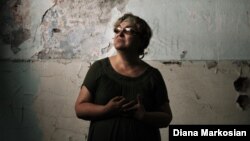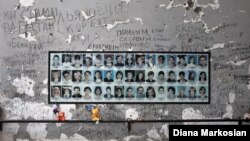BESLAN, Russia -- Nadezhda Guriyeva huddled with her children on the floor of the sweltering school gymnasium. An explosive device rested ominously just a few feet away. The two older children, Boris and Vera, were dressed for a folk dance performance to celebrate the first day of school. The festivities never began.
Boris and Vera were among the 334 people, including 186 children, killed amid explosions and a hail of bullets after being held captive for two days in a terrorist attack on School No. 1 in Beslan. Guriyeva’s youngest daughter, Irina, survived. The girl’s escape allowed Guriyeva to survive the aftermath of the horror.
"I had no choice," Guriyeva says. “I had my little daughter. She was always watching me to see if I cried. I couldn't even cry."
Ten years have passed since armed militants stormed the school on September 1, 2004, and took 1,100 children, mothers, and teachers hostage in the gymnasium. The ordeal came to an end 52 hours later. But for the survivors and their loved ones, it changed everything forever.
"Some left for good and completely altered their lives," says Guriyeva, who has taught at School No. 1 for 36 years. "Some dedicated their lives to investigating what happened. Some lend me a helping hand, for instance, with the museum [commemorating the tragedy]. Some still cry and live at the cemetery, trying to raise their children there.”
Guriyeva, 54, coped with witnessing the deaths of her own son and daughter in part by internalizing her sorrow. “I decided that, however terrible the grief, you must not transfer it to other people," she says. “It feels like it happened yesterday.”
After seizing the school that morning, dozens of Ingush and Chechen gunmen herded the hostages from the courtyard into the small gymnasium and rigged it with homemade bombs. They issued their demands: the withdrawal of Russian troops from the war-torn North Caucasus republic of Chechnya.
Guriyeva, who had already taught at the school for 26 years, was one of the last to be moved inside. Only then did she realize her three children were there.
“Ten years have gone by,” she says. “I just don't understand how we survived it. Not dying from the explosions, but from those 52 hours we spent there. It was real horror."
PHOTOS: Ten Years After Beslan, Memories Still Fresh (Click for photos in large format)
When the hostages failed to remain quiet, the gunmen executed a man at the front of the gymnasium to make their point.
At first children were allowed to use the bathroom, where they tried to drink water to bring short relief from the stifling hall at the end of a fiercely hot summer. To this day, mourners bring open bottles of water to the gymnasium as offerings to the dead. Boris, 14, was running a temperature that day and was too weak to go.
“The militants broke the sinks and smashed the pipes so that we couldn't drink water,” Guriyeva says. “The [children] tried to soak it up in their shirts where it dripped in order to bring it back. Some children brought their moms water in their mouths."
Negotiations made no progress, and by the second day almost no children were allowed out.
‘Tears Of Blood’
After midday on September 3, Guriyeva remembers an almost delirious longing for the standoff to end -- whatever the consequences. It soon did. A deadly silence had often reigned in the hall. The militants had fired shots into the ceiling to keep them still. But already the hundreds of captives were becoming unruly.
Shortly after 1:00 p.m., a powerful explosion shook the gymnasium.
Those who could summon the strength stood up and ran, though many were promptly gunned down as they fled, Guriyeva says. “From the second-floor attic, the militants began firing at the backs of the children running away,” she says.
One little girl who managed to escape ran straight to a drinking fountain, Guriyeva recalls. “She couldn't stay away from the fountain -- to the water,” she says. “A sniper killed her on the spot."
PHOTOS: Beslan -- Three Days Of Terror (Click for photos in large format)
A second explosion followed quickly, bringing the roof down and igniting a fire. "When I came to, my little Verochka was no longer alive,” Guriyeva says.
She points to a photograph of Vera, who was 11 years old at the time of the attack.
“She had the same expression as she has there. She had exactly that smile, only her eyes were closed and there were tears of blood on her cheeks,” Guriyeva says.
In her hand, Guriyeva recalls, Vera clasped a cross that she had found, and her arms were crossed over her chest. She had a shrapnel wound in the back of her head.
Both Boris’s and Vera’s remains would be scorched in the blaze that tore through the gym. Vera’s body was identified from the traditional dress she had worn for the planned folk dance.
Boris was covered in blood, much of it Guriyeva’s. But shrapnel had penetrated his stomach and exited through his back.
Irina suffered only minor injuries, and Guriyeva told her to make a dash for it. Boris was still breathing, and Guriyeva stayed with him. With her arm badly injured, however, he was too heavy to carry. She dragged him to a group of hostages who were also unable to move due to their injuries. Fragments of body parts lay nearby.
The militants ordered Guriyeva out of the gymnasium toward the cafeteria. Grabbing a small girl by the hand, she ended up in the adjacent kitchen where, parched, they drank filthy water that their captors had used to defrost chicken legs. She told the little girl to wait for her there and returned to get Boris. The militants stopped her and turned her away. One of them smashed out her teeth with a rifle.
As Russian special forces moved in, Guriyeva escaped out of a window. Irina had made it, too.
"After such a cruel situation, every person has to find meaning in life again, to find something to live for -- or to just fade away and end up in the cemetery, too. We had suicides among adult men. A fair number of our men ended their own lives."
Questions still persist about culpability in the bloody conclusion of the crisis, including whether the militants or Russian security forces initiated the final firefight. Some were unable to forget these questions.
Guriyeva’s husband, Stanislav, was tormented by thoughts of revenge and the conflicting belief that finding those responsible was impossible, and that mindless violence leads to more violence, she explains.
A year and a half ago, at age 46, Stanislav passed away. He had turned to alcohol. "He couldn't sort himself out. He turned to alcohol to forget, and alcohol finished him off,” Guriyeva says.
‘A New Life’
Two months after the tragedy, Guriyeva was teaching again.
"My first lesson was with my son's old class," she says. "I was walking down the hallway and a little girl came up to me and said: 'Great, Nadezhda, you've come! Where's Borya?' People didn't know at that point who had died and who hadn't. Our first class, we simply cried together."
But for Guriyeva, her teaching was also a source of strength. It’s like acting, she says.
“Whether you like it or not, whether it hurts or not, whether your heart is breaking into pieces, you have to go out and teach children,” she says. “I had 10 children outside the school classes whose homes I worked at. Before going in, it was: deep breath, put a smile on and go in, finish teaching, go out and cry all the way to the next home. Some of the children were so difficult.”
A new school was built opposite School No. 1, across the railway tracks where cows and goats graze. Multicolored lettering above the entrance proclaims “The start of a new life.”
But for Guriyeva, it’s not about escaping the past.
“The story of School No. 1 is our story,” she says. “The terrorist attack is our story. It’s hard. It’s terrifying. It’s bloody. But it is our story. We remember it. We didn’t move to a new school and begin a new life. We didn’t start afresh. We continue to live our life.”



